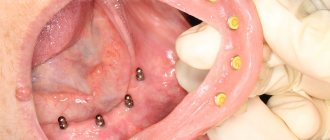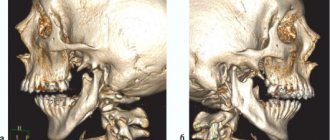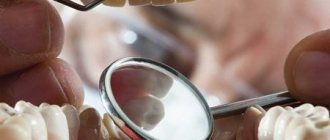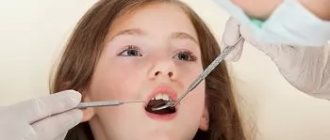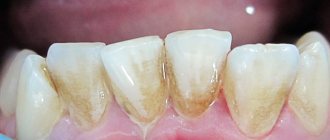Symptoms Causes Features Diagnostics Treatment methods Whitening Prevention
Tetracycline teeth are a type of systemic enamel hypoplasia that occurs as a result of taking antibiotics of the tetracycline group, when teeth and their rudiments are formed, and mineralization of dental and bone tissue occurs. It is characterized by a pronounced change in the color of the enamel and its structural disturbance. The cutting edges of the incisors and the chewing surface of the molars are painted. The color of tetracycline teeth can vary from bright yellow to blue-brown, the severity of the shade depends on the drug, its dose, and duration of use. Not only the surface enamel layer is stained, but also deeper tissues, which makes it difficult to restore natural whiteness.
Symptoms
- Persistent irreversible discoloration;
- pigmentation of gray, yellow, brown, brown shade;
- the entire crown or a separate area is painted;
- thinning of enamel, cracks, chips;
- sensitivity to hot, cold;
- Tetracycline staining of teeth is uneven, looks like transverse stripes on the enamel.
Causes of pathology
The main negative factor of medical discoloration is the use of tetracycline antibiotics during the formation and mineralization of dental tissues. That is, in the prenatal period, up to 8-12 years
, while milk units are being replaced with permanent ones. The antibiotic does not have this effect on adults. The side effect occurs due to the ability of tetracycline to bind with calcium to form stable compounds that are deposited in areas where mineralization is currently occurring - bones, teeth and their rudiments.
The severity of the changes depends on the dosage of the drug and duration of use. The higher the dosage and the longer the course of treatment, the darker the enamel, the more complex its structural disorders, even underdevelopment.
Tetracycline staining of teeth is rare, since such antibiotics are prescribed to women during pregnancy and children under 8 years of age only in isolated clinical cases. Treatment with tetracycline is justified when the possible side effect of the drug is less dangerous than the consequences of the existing disease.
Prevention
The risks of tetracycline teeth are now a well-known problem, so doctors familiar with it try to avoid, if possible, recommending tetracycline antibiotics for pregnant women and children under 12 years of age. But if there are no other possibilities, then, unfortunately, you have to choose the priority of the general health of the mother and child. The doctor may try to make the course of antibiotic therapy as short as possible, since the inclusion of antibiotic molecules in growing dental tissues is a process that takes quite a long time.
Request a consultation
Features of tetracycline staining
Staining under the influence of tetracycline is referred to as deep pigmentation of hard dental tissues. The discoloration may cover the entire coronal part or be observed in individual areas of the tooth. Under the influence of light and food coloring, the color of the enamel changes and becomes darker. Typically, the color appears as a transverse stripe around the crown with the greatest color intensity in the cervical area.
For a long time, the problem of tetracycline dental discoloration was associated with pediatric patients. But similar pathologies also occur in adults, for example, after long-term use of minomycin in the treatment of acne.
What affects the color of teeth
Depending on the dosage of antibiotics of this series the patient took, his teeth may acquire one of the following shades:
- yellow or lemon;
- brown;
- grey;
- orange;
- combination of brown with yellow or orange;
- brown;
- dark grey.
However, not only the dosage of the drug affects the condition of tooth enamel. Its color changes under the influence of many factors, including:
- individual characteristics of a person;
- time flow;
- consumption of food additives and dyes;
- sunlight;
- allergic reactions.
Tetracycline stains are more often a cosmetic defect, without causing significant harm to the body by their presence.
Diagnostics
The diagnosis is based on an examination, anamnesis, and clinical examination. Since the pathology has common symptoms with other lesions of hard dental tissues, differential diagnosis of tetracycline teeth is carried out with the following pathologies:
- fluorosis;
- hemolytic disease of newborns;
- dentin dysplasia;
- congenital discoloration due to Rh conflict during pregnancy;
- amelogenesis imperfecta;
- Stanton-Cadelon syndrome.
The dentist conducts a dental examination under ultraviolet light. Under UV radiation, tetracycline sites fluoresce (glow). The intensity of the glow depends on the amount of accumulated drug in the tissues. This is an absolute guarantee of accurate diagnosis, since tooth staining due to other reasons does not fluoresce under UV radiation.
There are no specific abnormalities in the OPTG image. Upon examination, tetracycline teeth are painless, have a rough surface, and there are symptoms of enamel hypoplasia.
Why is this happening?
Tetracycline teeth can occur for only two reasons. Most often, the process of pathological changes in enamel occurs in the womb. This is possible if the expectant mother was prescribed tetracycline-based drugs for some reason. Dentists note that even a short course of treatment (2-3 days) can provoke this disease.
The second reason is taking medication during the eruption of permanent teeth, which usually occurs at 7-9 years of age. The teeth themselves will not become snow-white again if no measures are taken. Even in adulthood, the units will still remain dark with uneven coloration.
Treatment methods
Treatment of tetracycline teeth is complex, aimed at eliminating discoloration and strengthening the enamel. To replenish the mineral composition of the enamel layer, remineralizing therapy is carried out - applications of fluoride and calcium-containing drugs, electro- and phonophoresis. Usually a course of 10-12 procedures
, if necessary, repeat it. For greater protection, crowns are coated with fluoride varnish.
Tetracycline staining is an irreversible discoloration
. Therefore, the second part of the therapy is aimed at aesthetic correction of teeth. To eliminate the aesthetic defect, tetracycline teeth in children are restored with a glass ionomer composition. The material is characterized by high adhesion to dental tissues and does not require surface treatment with acid-containing agents, which is important when the enamel is fragile. After application to the surface, the composite begins to release fluoride ions, which penetrate deep into the dental tissues, providing additional protection against caries.
In older age, to eliminate discoloration, whitening and orthopedic methods of color correction are used - veneering, prosthetics with crowns. Veneers and lumineers completely eliminate the aesthetic defect, regardless of the intensity of pigmentation. Teeth are subject to restoration along the smile line ( 8-10
upper,
6-8
lower central units).
Can it be avoided?
In order to protect yourself from defects, you should be careful about the medications you take. Use tetracycline only as prescribed by a doctor; usually, therapists and other specialists prescribe antibiotics only when absolutely necessary.
In the event that an infant or an older child falls ill, and the pediatrician prescribes a tetracycline-containing drug, the dosage should be observed as accurately as possible, it should be reduced by him, and do not continue the course more than indicated.
Teeth exposed to this antibiotic cause discomfort to their owner. In order to avoid such problems, you should approach any course of therapy wisely and not self-medicate.
Can tetracycline teeth be whitened?
With slight or moderate pigmentation, the aesthetics of the dentition can be improved with the help of whitening. The final result depends on the initial shade of the enamel and the saturation of its original color. Given the unpredictable nature of individual shade changes during the procedure, achieving a specific effect is very difficult. Once the potentially achievable whiteness has been achieved, all subsequent attempts to improve the result are futile.
Whitening AMAZING WHITE
The method is effective for minor pigmentation. It is impossible to achieve ideal whiteness with its help, since the color change occurred from within the fabrics. The procedure takes about an hour; a gel with hydrogen peroxide and additional substances that help strengthen the enamel is applied to the surface of the teeth. Under the influence of a special lamp, the active substance is released, penetrates deep into the enamel, and breaks down coloring pigments.
Whitening ZOOM
Whitening tetracycline teeth with the ZOOM system will help improve the aesthetics of mild to moderate pigmentation (light gray or light yellow teeth). For bright gray or yellow shades, ZOOM whitening can also be used, but the effect will be less pronounced. To restore aesthetics, more than one procedure may be required. That is, tetracycline teeth can be lightened using whitening, but the result depends on the initial clinical data. Under positive clinical conditions, the color of the enamel after a course of treatment brightens by 10-12 tones
.
Combined teeth whitening with tetracycline will give results if the enamel is stained slightly, evenly, in any one shade. With uneven, intense pigmentation (the enamel is painted in stripes of blue, brown-orange, dark gray), the procedure is ineffective, and relapse is observed in the shortest possible time. The doctor selects the restoration method after a comprehensive analysis of the clinical situation.
Remineralization of tooth enamel
The lack of mineral components during the formation of enamel is the main source of the formation of tetracycline teeth. When restoring enamel, applications with calcium gloconate and sodium fluoride are effective. The phonophoresis procedure is used. The goal of therapy is to supply ions of the main elements to the enamel: calcium, phosphorus and fluorine.
Treatment is carried out in the clinic, and in case of slight darkening, outpatient treatment at home is allowed. Up to 20 procedures will be required. If performed daily, therapy will end after three weeks or earlier. With a course of use every other day, it will take up to one and a half months.
In this case, the patient did not have any serious problems with aesthetics. I wanted to significantly lighten my teeth and improve their shape. If we were talking about traditional veneers, we would dissuade the patient from the procedure.
There is no point in sacrificing dental health for aesthetics. In this case, the patient did not have any serious problems with aesthetics. I wanted to significantly lighten my teeth and improve their shape. If we were talking about traditional veneers, we would dissuade the patient from the procedure. There is no point in sacrificing dental health for aesthetics.
With Luxneers you don’t have to choose between health and beauty - you can create a perfect smile without sacrifice! The teeth are not subjected to grinding and you can return to your “natural smile” at any time. The procedure is comfortable, installation is absolutely painless!
Find out more about Luxneers no-preparation veneers
